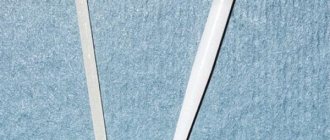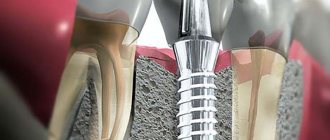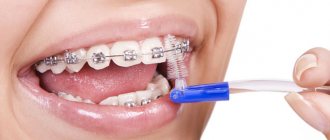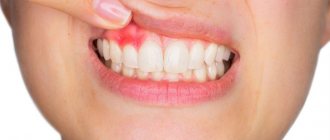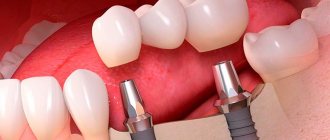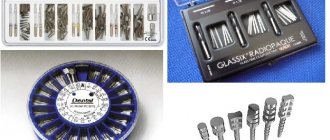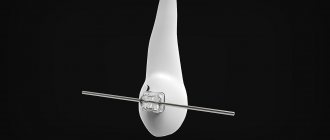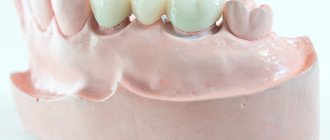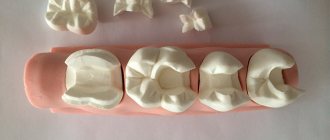Today, dozens of methods have been developed to restore and correct teeth, each of which is designed to quickly and painlessly solve a specific clinical problem. In cases of carious destruction, inlays have proven themselves to be the best, and if the tooth lacks support, pins come to the rescue.
The installation of a pin during dental prosthetics is carried out as follows: one end of the rod is screwed into the root canal, and a new beautiful tooth is attached to the other.
What is a dental pin
Dentists call a pin a special threaded rod.
With its help, one end of the pin is screwed into the root of the tooth, and a prosthesis is installed on the other end of the structure. The pin method of tooth extension is relevant in cases where the upper part of the tooth is severely damaged, and the root canals are in normal condition.
Advantages
- Aesthetics. The technology allows you to restore a beautiful appearance to severely destroyed and damaged teeth, including the front ones.
- Preservation of the tooth root, which does not happen with implantation.
- Functionality. Artificial pin teeth fully cope with the functions of natural ones, without causing any inconvenience and without requiring special care.
- Long service life. A tooth attached to a pin lasts more than 10 years.
Risks of pin prosthetics
- In the case when the pin is installed in a weakened root, thinning of the tooth walls with subsequent destruction is possible.
- Incorrect installation can lead to the spread of the carious process.
- Metal pins, although to a small extent, are still susceptible to corrosion.
- When removing a pin, it may be necessary to remove it along with the root.
- Individual intolerance to the materials from which the pin is made is possible.
In what cases do you resort to installing an anchor rod?
If the visible part of a tooth is destroyed by more than 30%, it can be restored using filling materials, but it is not a fact that the result of such work will last long enough. By resorting to the help of an intracanal design, it is possible to achieve high adhesion strength of the restoration material or a full-fledged crown with the root system of the tooth, even if it is severely destroyed. It is important that the root canals are healthy, and then with the help of this design it is possible to save the damaged element.
The pin is used for partially destroyed teeth
Thus, anchor pins have found wide application in dental restoration in cases of destruction of varying degrees of complexity, including the almost complete absence of the external part of the element. Installation of the structure is possible if there are hard tissues at a height of at least 2-3 mm above the gum level. In addition, an x-ray must confirm the satisfactory condition of the root with a thickness of at least 2 mm1. Such a rod will ensure a more correct distribution of pressure on the tooth, restore its functionality and allow the patient to return to their normal lifestyle, without giving up solid foods.
What is a pin in a tooth for?
The decision on the advisability of pin extension is made by the doctor. Indications for using the pin method are:
- Destruction of the dental crown by more than 50 percent.
- Severe weakening of tooth enamel as a result of dental diseases or their treatment.
- The need to create a strong support for prosthetics.
- Extracting the tooth while the infection is being treated and then returning it to the socket.
Indications
Often, after some time, caries develops under the crown around the pin devices. As a result, the oral cavity requires repeated sanitation. And the main task of canal re-treatment is to remove the foreign body from the root canal. Indications for removal are pain under the crown, tooth decay and deep caries. Most often this concerns pins that were installed a long time ago.
One of the serious indications for re-treatment of canals is a foreign body, or rather a fiberglass rod or its fragments. Before starting this procedure, be sure to take an x-ray.
Contraindications
In some cases, the pin design is contraindicated. The possibility of installing pins for dental prosthetics is determined by the doctor after studying the medical history, conducting an examination of the damaged tooth and assessing the condition of the oral cavity.
In most cases, inflammatory processes in the oral cavity immediately become an obstacle to placing a pin. In this case, pin structures are installed after treatment.
Direct contraindications to the installation of pins are:
- absence of a tooth crown in the frontal part;
- narrowness of the root canals: width less than two millimeters;
- impossibility of giving a cylindrical shape to the root canal;
- insufficient root height;
- the presence of cysts and granulomas in the oral cavity;
- blood clotting disorders, including during menstruation in women;
- pregnancy;
- mental disorders;
- any dental diseases of an inflammatory nature in the acute stage;
- complete destruction of the tooth crown.
What are the advantages and disadvantages?
Anchor pins have found widespread use in dentistry, and for good reason. Here are the main advantages characteristic of this type of structure:
- strength and reliability - the retainer copes well with its main function, namely holding the restored part of the tooth or an installed crown, and can withstand fairly high chewing loads,
- reasonable cost in comparison with more modern varieties of similar products,
- the speed of the procedure, which usually does not take more than an hour,
- possibility of fixing a fully functional prosthesis – an artificial crown.
However, such products today are gradually fading into the background, as experts increasingly prefer improved modifications made from modern materials. Thus, the disadvantages of anchor structures include the risk of damage to the canal walls during installation, the possible negative influence of metals, including the risk of developing an allergic reaction, poor aesthetics - over time, the metal component will begin to show through. Such products are very firmly fixed with a cement composition and are sometimes difficult to remove, hence another problem - the likelihood of root perforation.
Types of pins in dentistry
Dental pins vary in material, elasticity, fixation method and shape. The doctor selects a suitable design after a thorough examination, conducting the necessary studies and interviewing the patient. To make sure that there are no contraindications to installing the rod and that the width and depth of the canals are sufficient, the doctor must conduct an X-ray examination.
By material
- The anchor pin is the most popular in dentistry. This is due to the fact that it helps restore teeth with the maximum degree of crown destruction. The condition of the tooth root is extremely important: the pin can only be installed if it is intact and healthy. The product is made from an alloy of various metals: stainless steel, brass, palladium, titanium and even gold. Due to their high strength, lightness and low cost, titanium pins are most often used in dentistry. The main advantage of the anchor pin is the reliable retention of the restored part of the tooth and the possibility of further installation of dentures.
Disadvantages include susceptibility to corrosion, difficulty in removal and visibility. Anchor pins can be installed either passively or actively. - Fiberglass pin is the second most popular. Its difference lies in its high elasticity, hypoallergenicity and easy removal. The structure is made by dipping fiberglass into a plastic mold in such a way that an equivalent load is created on the hard tissues of the tooth. Visually, the fiberglass pin is almost invisible (see photo), since its color matches the enamel pigment. The disadvantage of the product is the 15 percent probability of destruction of dental tissue.
- Carbon fiber dental pins are very elastic, which reduces the load on the tooth root and prevents canal fracture. The structure of the material is close to the dentin layer of a natural tooth, making the product strong and durable.
- Parapulpal rods are made of a metal alloy and coated on the outside with polymer. They are used primarily for reinforcing filling material with a tooth cavity. They are inserted into hard tissues without penetrating the pulp. On the one hand, this eliminates the possibility of bacteria penetrating inside and developing inflammation, on the other hand, it limits the range of applications.
By elasticity
- Elastic pins better protect the tooth from fractures and impacts.
- Inelastic ones are preferred for supporting restorative structures, prostheses and bridges.
Pin Shape
When choosing the shape of the rod, the doctor proceeds from the individual shape of the root canal. The following rod shapes have been developed:
- conical;
- cylindrical;
- cylindrical-conical;
- screw.
Installation methods
- Active. The rod is screwed into the root of the tooth using a thread and is used as a support for a full crown.
- Passive. The rod is inserted and fixed into the root canal using special cement; it does not need to be screwed in. The strength of the structure is lower, but this method is more gentle on tooth tissue.
Cylindrical and tapered pins
A dental pin can be of various shapes. The photo, for example, shows a cylindrical and a conical one. They are considered the most common classic design options, as they repeat the anatomy and structure of the tooth root. Such products are created directly in production, i.e. they are standard or templated and then delivered to dental offices.
Cylindrical and conical pins in dentistry
There are also cylindrical-conical and screw products. Their choice is based on the characteristics of each individual patient and the structure of the tooth canal to be restored.
It must be emphasized that active and passive, as well as cylindrical and conical structures can be either metallic or non-metallic.
Installation of pins for dental prosthetics
Installed pin
Preparations for the installation of pin structures should not be made on the day of the operation, but during a preliminary consultation. After the dentist has determined the feasibility and possibility of pin prosthetics, he must analyze in detail the condition of the tooth and study the thickness of its tissues. Taking into account all factors, the doctor selects the optimal materials and types of fastening.
If inflammatory processes and any other pathologies that may complicate the operation have been identified, they are treated.
After this, additional inspection is required. When the doctor is convinced that there are no contraindications, immediate preparation for prosthetics will begin.
The day before the installation of the pin, it is recommended to undergo a teeth cleaning procedure to remove stones and plaque. This will help minimize the number of bacteria that can get onto the wound surface after manipulation. You should not eat for six hours before the pin is inserted.
Procedure
First of all, an injection of anesthesia is injected into the gum to numb the area of work. After the anesthesia has taken effect and the doctor has checked the surface for susceptibility, installation work begins. The dentist prepares the root canal, removes nerves, cleans and, if necessary, widens the canal. The work area is treated with an antiseptic solution.
If a passive pin is used, the channel is pre-filled with a cementitious mixture, and the rod is immersed in it. The active pin is screwed into the channel, and the voids are filled with a polymer composition. For better fixation, the solution is dried with a halogen lamp.
Photo: how to place a pin in a tooth
When the rod is screwed in and securely fixed, a pre-made artificial tooth prosthesis is placed on it. Temporary cement is used for fixation; this is done in order to test the material for rejection. If the surrounding tissues of the oral cavity reacted normally to the foreign element, after a week the denture is placed on a permanent basis. If necessary, the doctor adjusts it using grinding. After installing the pin, the patient should not have the slightest discomfort,
the further outcome of treatment depends on strict adherence to the dentist’s recommendations.
Rehabilitation
The first time after installing the pin, you must strictly adhere to a number of restrictions and recommendations. Only the doctor who performed the treatment can say how long the rehabilitation period will last. For the entire period of rehabilitation you should:
- Eliminate from the diet hard and viscous foods that require active chewing movements. Food should be soft or even ground.
- On the first day you should not brush your teeth, only rinsing is acceptable. In the future, you will need to give preference to brushes with soft or medium bristles.
- Avoid foods and items that can damage the integrity of your teeth: nuts, seeds, toothpicks.
- Do not miss visits to the dentist and strictly follow individual recommendations.
What is the procedure for removing the pin?
At the beginning of the procedure, a rubber dam is installed (latex scarves that are fixed on the teeth with special metal clamps, “clamps”; they are used to isolate the working field). After this, the tooth is thoroughly cleaned of the old filling material to release the pin rod. Then the rod is carefully processed with an ultrasonic instrument, while the pin is gradually loosened and removed from the canal, trying to preserve the tooth tissue as much as possible.
The anchor pin rod is also previously freed from the seal. Then they loosen it with ultrasound and carefully twist it out of the dental cavity.
Parapulpal rods are much easier to pull out than other types of pins. They are not inserted deep into the canal, so no deep intervention is required to remove them. In most cases, it is enough to grab the end and remove it by slightly loosening it. It is not necessary to use ultrasonic devices.
How much does it cost to install a pin?
The price for installing an artificial tooth on a pin depends on the region and the type of product chosen. In Moscow clinics, dentists traditionally charge more for dentures. A titanium anchor per tooth will cost the least; a fiberglass pin will cost 2.5 times more.
It is important to proceed from the advisability of installing one type of pin or another. It is necessary to take into account what will be best for the teeth, in which part of the jaw the manipulations are performed, whether subsequent prosthetics are planned, what is the budget for treatment. An experienced dentist will help you choose the best option.
Alternative restoration options
Many dentists today try to avoid anchors because they now have more modern and reliable products at their disposal that do not have many of the disadvantages inherent in metal rods. The priority is ceramics for the front teeth, as well as fiberglass - a durable and fairly elastic material that can withstand high loads, but without compromising the aesthetic component. Among the advantages of fiberglass products are the following:
- no risk of allergies,
- simple and safe installation,
- preservation of the walls of the root canal in the long term,
- ease of removal of the structure, and the possibility of its return in place after treatment,
- the ability to achieve high aesthetics during restoration,
- strength and reliability.
Fiberglass pin makes it possible to achieve high aesthetics in prosthetics
“I had one of my front teeth restored, and the doctor immediately said that it would be better to use a fiberglass pin. It is ideal for the smile area, does not show through over time, and holds firmly. In my case, the result exceeded all my expectations - the tooth is exactly the same as all the others, I don’t notice any differences. About a year passed and no visible changes occurred. And I’ve never heard of an allergy to fiberglass...”
Olga, from correspondence on the woman.ru forum
Fiberglass is absolutely resistant to the aggressive external environment of the oral cavity. In addition, this is an excellent option if the restoration is carried out without the use of prosthetic products, namely with the help of composite materials - the fibers have a matte white color, so they will not show through the composite and thereby spoil the appearance of the smile. Installation is less traumatic, and the risk of root damage remains minimal.
Does it hurt to put a pin in a tooth?
It doesn't hurt to put a pin in a tooth
, since with such prosthetics local anesthesia is used. Once the procedure is completed and the anesthesia wears off, there may be some discomfort, but there will be no pain even after the procedure.
Before making a final decision in favor of prosthetics using a pin, you need to consult with the dentistry department. The doctor must explain how the procedure will take place, why to insert this or that material, what the consequences are and whether there are guarantees for the installed structure. The pin is installed for a long time, so it is important to choose an experienced specialist who will select the right material and professionally carry out prosthetics.
Possible complications
Installation of the anchor pin is usually quick and without complications. Problems may arise due to the patient's allergy to metals. In such a situation, swelling usually develops, the gums in the area of the restored tooth turn red, and itching appears. If such symptoms are detected, you should immediately contact your dentist to remove the structure. If a specialist made mistakes during the treatment process or carried out insufficiently high-quality antiseptic treatment, there may be a risk of developing an inflammatory process - stomatitis, periodontitis.
Swelling after treatment may be a sign of complications
Immediately after the procedure, when the anesthesia wears off, discomfort and moderate pain may appear - this is a completely natural phenomenon, a reaction to tissue injury that inevitably occurs during root canal treatment and restoration of a damaged tooth. The symptoms will go away after a couple of days, but in the meantime, pharmaceutical painkillers will help alleviate the condition. If the pain and intensity of symptoms only increases, it is better to see a specialist. Perhaps the whole point is damage to the walls of the root canal.
